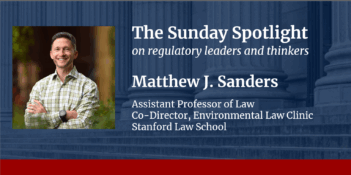
Major rules, especially EPA’s, potentially create enormous net benefits.
Federal regulations from the last ten years, though costly, could potentially generate almost a trillion dollars in net benefits. Environmental regulations, especially those issued under the Clean Air Act, will likely create the largest benefits. And, the Obama Administration, through its first four years, may be better than the two previous administrations at enacting beneficial regulations.
Those are some of the key insights from the recently-released draft version of the Office of Management and Budget’s (OMB) annual Report to Congress on the Benefit and Costs of Federal Regulation. As required by the Regulatory-Right-To-Know Act, the OMB annually summarizes estimated costs and benefits of major federal regulations and presents the findings to Congress.
In the latest report, the OMB concludes that major federal regulations enacted in the last ten years are expected to produce a net benefit between $109 billion and $743 billion. Cost estimates range between $57 billion and $84 billion, whereas benefit estimates range from $193 billion to $800 billion.
The data for the last ten years show a high degree of concentration in large-scale rulemaking, as two agencies – the Environmental Protection Agency (EPA) and the Department of Transportation (DOT) – issued a majority of major rules. In all, the four most active agencies – EPA, DOT, the Department of Health and Human Services (HHS), and the Department of Energy – accounted for 95 of the 115 total rules issued.
According to the report, the EPA, in particular its Office of Air and Radiation, issued the three highest impact regulations of the last ten years, as measured by both expected benefits and costs – all under the Clean Air Act. EPA rules account for 58 to 80 percent of total estimated benefits and 44 to 54 percent of total estimated costs. The EPA also enacted the highest impact regulation in 2012, the National Emission Standards for Hazardous Air Pollutants from Coal- and Oil-Fired Electric Utility Steam, which will cost around $8.2 billion but is expected to produce benefits of up to $76.9 billion. The OMB notes that the high costs imposed by EPA rules have made them especially controversial even though the expected benefits still dwarf the costs.
The report also presents a year-by-year look at the costs and benefits of major rules. While the number of major regulations issued has stayed relatively stable over the last ten years, regulations’ impacts have varied greatly. For example, the highest impact year, 2007, had major regulations with expected net benefits between $28.6 billion and $184.2 billion. The lowest impact year, 2003, enacted rules with expected net benefits between $1.6 billion and $4.5 billion.
In addition to providing a ten-year review of the estimated net benefits of major federal regulations, the draft OMB report catalogues each of the 47 major rules that were enacted in 2012. This analysis does not include 22 “transfer” rules which primarily cause income transfers from one demographic group (usually taxpayers) to another (usually program beneficiaries) and generally do not distort private market incentives in the same way that private-sector mandates do. Unlike the past ten years, in which environmental agencies dominated rulemaking, the year 2012 saw HHS issue the highest number of major rules, including fourteen “transfer” rules and seven “economically significant” rules.
One of the most interesting parts of the draft report is OMB’s comparison of the three most recent administrations – Clinton, Bush, and Obama – based on net benefits created by major regulations. Using estimates from only the first four years of each administration, presumably to allow for a better comparison at this point in the Obama presidency, the OMB finds that major regulations issued under President Obama are expected to produce greater expected benefits than those issued under Presidents Clinton and Bush combined. Through the first four years of President Obama’s term, major rules from executive agencies are expected to generate $159.2 billion in net benefits. The comparable figure for President Clinton was $30.0 billion, while that for President Bush was $60.0 billion.
This last analysis has – perhaps predictably – faced criticism. Susan Dudley, the head of the George Washington University Regulatory Studies Center and formerly head of regulatory review under President George W. Bush, has pointed out that major rules under the Obama Administration have been much more costly than those under the previous administrations. Thus, when excluding projected benefits from the analysis, an analytical move she believes is warranted by the fact that “[t]he benefits are very different in character from the costs … [and] derive from … assumptions that many scholars find questionable,” Obama regulations have placed greater burden on the economy than those under President Clinton or President Bush.
The draft OMB report, although comprehensive, suffers from several key challenges, many of which OMB explicitly acknowledges.
First, the report only accounts for “major” regulations, that is, those expected to generate economic impacts of $100 million or more in any one year. This requirement for “major” rules shrinks the pool of data dramatically to 115 rules out of the total 37,786 final rules that were published in the Federal Register in the last ten years. Still, the OMB explains that the focus on major rules is justified because they produce a majority of costs and benefits.
Second, the figures include only estimates for regulations by executive agencies and do not account for regulations by independent agencies, such as the Commodity Futures Trading Commission (CFTC) and the Securities and Exchange Commission (SEC). There were 21 such major regulations in 2012, for example.
Third, the report only includes anticipated regulatory effects that agencies were able to monetize. In many cases, agencies do not have the necessary information to quantify or monetize benefits or costs. Furthermore, agencies may rely on assumptions that prove to be erroneous. The estimates of costs and benefits in the report are just that: estimates. They are estimates produced before rules are adopted and are not based on any research conducted after regulations have been implemented. The OMB notes that such limitations help explain the huge range of estimates that the agencies provide.
Finally, although the OMB authored the draft report, it mostly played the role of a compiler. The agencies themselves conduct cost-benefit analyses in accordance with Executive Orders 12,866 and 13,563. The projected numbers do undergo internal and external review, including review by OMB. But in the end, the OMB’s analysis is only as good as the estimates the agencies provide.
At the end of its draft report, the OMB makes several recommendations for regulatory reform. For example, the report suggests that regulations should use plain language to facilitate public participation and promote transparency. Also, the OMB recommends that agencies use “objective, evidence-based assessment of costs and benefits” as well as that agencies conduct retrospective reviews of their regulations to better understand the true impact of regulations and help determine the accuracy of the estimates agencies produce prior to the adoption of new regulations.



